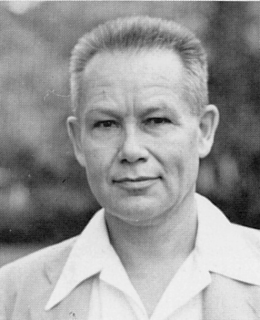
HAROLD ST. JOHN (1892-1991), for whom the St. John Plant Laboratory is named, was an eminent botanist and UH professor. The son of a Unitarian minister, he was born in Pittsburgh. Graduate education, work with a Canadian botanical survey, and combat service in France during WWI occupied him until 1920, when he receive a Ph.D. in biology from Harvard. He taught at the State College of Washington (now Washington State University) before accepting an invitation to come to UH. The Harold St. John Plant Science Laboratory building was dedicated on November 29, 1971. Dr. St. John taught at the University from 1929 to 1958 and often served as the Botany Department's chairman.

University photo by Masao Miyamoto
Although he continued to teach at UH during most of the WWII years, he was granted a leave of absence for work with the Foreign Economic Administration. He led a scientific team to the jungles of Colombia in search of Cinchona trees. The war had disrupted ordinary supply lines for the malaria drug quinine, and the Colombia trees were seen an alternate source of the bark from which quinine is made. St. John reported that his team harvested 60,000 tons of bark. After the war, under the auspices of the US Atomic Energy Commission, St. John investigated the effects of radiation on vegetation.
St. John's speciality was systematic botany, the classification of higher plants. He is especially known for his work for discovering some 500 new species of pandanus. He was a prolific writer, and published over 400 articles in addition to several books. His best known book, one considered a classic, is List and Summary of the Flowering Plants of the Hawaiian Islands. During the course of his adventurous life, he traveled extensively on botanical expeditions throughout the Pacific islands, and was one of several UH scientists who, following WWII, opened the Pacific islands to modern scientific discoveries. He taught at various colleges, including the College of Hue in Vietnam from 1959-61, after his retirement from the University of Hawaii as well as continuing his botanical work at the Bishop Museum.
____________
* Dr. Harold St. John [interview transcripts] Watamull Foundation Oral History Project, 1987.
* Kobayashi, Victor N. Building a Rainbow (Hui o Students, University of Hawaii at Manoa, 1983)
* Guide to the Harold St. John Papers 1912-1957 [http://nwda-db.wsulibs.wsu.edu/documents/retrieve.asp?docname=NTE2cg319.xml#bioghistID]